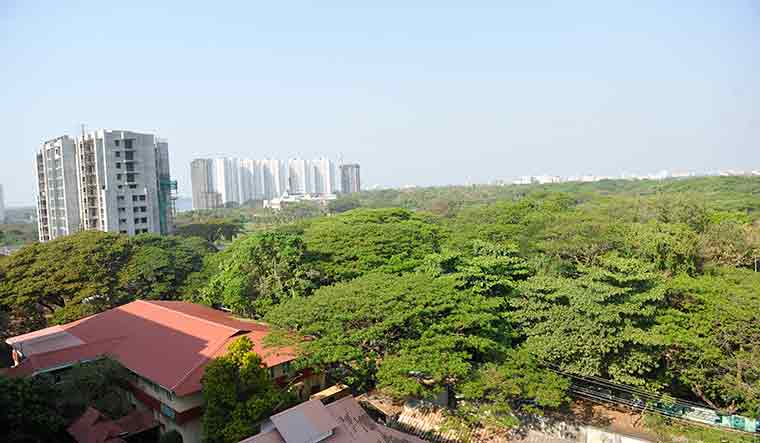Why India needs stable urban forests

- 24 May 2025
In News:
Urban forests are increasingly emerging as critical ecological buffers amidst India’s rapidly expanding cities. The recent controversy over the Kancha Gachibowli forest in Hyderabad—where 400 acres of urban forest land were earmarked for industrial development—has reignited debates on sustainable urbanisation and environmental governance. The Supreme Court’s intervention to halt further deforestation underscores the urgent need to prioritise ecological assets in urban planning.
Importance of Urban Forests
Urban forests such as Kancha Gachibowli (Hyderabad), Aarey (Mumbai), Turahalli (Bengaluru), Neela Hauz and the Ridge (Delhi), and Dol Ka Baadh (Jaipur) play a vital role in maintaining ecological balance within metropolitan environments. Their multifaceted contributions include:
- Air Pollution Mitigation: Urban forests absorb pollutants such as PM2.5 and PM10, which are major contributors to urban air pollution from vehicular emissions and construction activity.
- A 2006 study by the USDA Forest Service found that one hectare of forest can remove approximately one ton of air pollutants annually.
- In November 2024, the Central Pollution Control Board (CPCB) recorded a hazardous AQI of 494 in Delhi, highlighting the urgent need for natural air purifiers.
- Climate Regulation: These forests help reduce the urban heat island effect, control stormwater runoff, and mitigate urban flooding and erosion.
- Carbon Sequestration: Trees in urban forests trap atmospheric carbon, contributing to climate change mitigation efforts.
- Biodiversity Preservation: They serve as urban habitats for endangered birds, insects, and other fauna, supporting biodiversity within city limits.
- Socio-Cultural Benefits: Urban forests offer green spaces for recreation, promote mental well-being, and enhance the overall livability of urban areas.
Threats and Challenges
Despite their importance, urban forests in India face increasing threats due to:
- Unregulated Urban Expansion: Urban planning often disregards ecological sustainability, prioritising infrastructure and industrial development over green spaces.
- Lack of Legal Clarity: State governments sometimes contest the status of forest lands, as seen in Telangana’s claim over Kancha Gachibowli, undermining forest protections.
- Real Estate Pressures: Encroachments and land-use changes for commercial gain are frequent, with environmental concerns often sidelined.
Judicial Interventions and Constitutional Provisions
Indian courts have played a pivotal role in safeguarding urban forests:
- T.N. GodavarmanThirumulpad Case (1996): Expanded the definition of "forest" to include areas recorded as forest in government records, irrespective of ownership or classification.
- Delhi High Court (2015): Directed the protection and notification of the Delhi Ridge forest.
- Supreme Court Stay on Aarey Tree Felling (2020): Responded to civil society petitions to preserve Mumbai’s Aarey forest.
- Rajasthan High Court Suo Motu Action (2024): Intervened against deforestation in biodiversity-rich Baran district.
Constitutional Backing:
- Article 21: Guarantees the Right to Life, interpreted by courts to include the right to a clean and healthy environment.
- Article 48A: Directs the State to protect and improve the environment.
- Article 51A(g): Makes it a fundamental duty of citizens to protect the natural environment.
Policy Interventions: Nagar Van Yojana
In response to growing ecological concerns, the Ministry of Environment, Forest and Climate Change (MoEF&CC) launched the Nagar Van Yojana in 2020 with the goal of developing 1,000 urban forests by 2027.
- As per the India State of Forest Report 2023, the initiative has already led to an increase of 1,445.81 sq km in tree and forest cover in urban areas.
- The scheme aligns with other policy frameworks such as the National Forest Policy (1988) and the National Mission for Green India (2014), which promote afforestation and ecological restoration.
Way Forward
To ensure sustainable urbanisation, India must:
- Integrate ecological planning into urban masterplans, with mandatory forest inventories and zoning protections.
- Strengthen legal protections for notified and unnotified forests within urban areas.
- Foster community participation and civil society engagement in urban environmental stewardship.
- Promote green infrastructure through Smart Cities and AMRUT missions.
Conclusion
Urban forests are not peripheral luxuries but ecological necessities. Their conservation is essential for ensuring environmental resilience, public health, and urban quality of life. As India continues its urbanisation journey, a harmonious balance between development and ecological preservation is indispensable.
